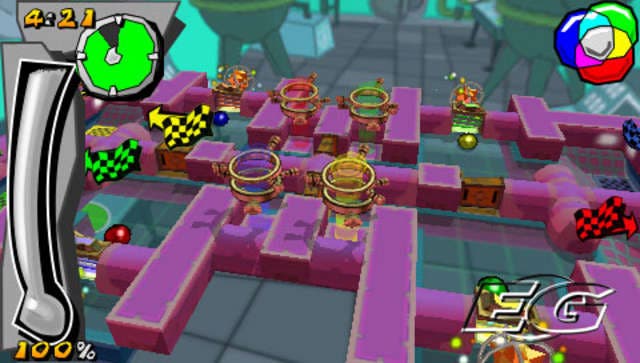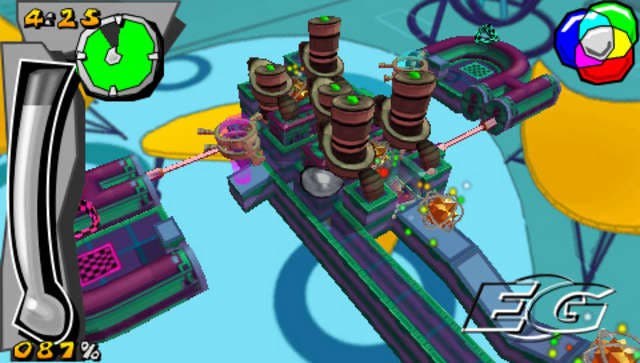Mercury Meltdown
The sequel. Butter whole lot better.
Ignition's Studio Manager Edward Bradley has just come back into the room to find me crashing his new game, Mercury Meltdown. Whoops.
"The big myth of the games industry is that it's hard to be a game designer," he says, as we fill a bit of time waiting for the devkit to reboot. "It's easy to be a game designer; it's turning the ideas into products that's the hard part." And when you do make it? "There's no shortage of ideas, just a shortage of time - which is a nice situation to be in."
Unsurprisingly, the conversation's slipped off a ledge into the realms of what was left over from the last game, a UK PSP launch title. And the answer, it turns out, is rather a lot.
"We didn't have the luxury of iterative design on the first one," he says. "It was get it right first time... or die! It was on the emulator until about five months before it was released, and it was on the unfinished libraries until a month before release."
No wonder there were problems then. And there were. Mercury - a game about moving a gelatinous blob of liquid metal around mazes, flicking switches and spray-painting it to move through coloured gates, all the while trying to avoid letting too much metal slice off or fall off the edge of the level - was widely praised but also savaged in places for its punishing difficulty and dodgy camera.

For the sequel, things are a bit better organised. There are new ideas, but most importantly Ignition Banbury (formerly Awesome Studios) has been able to sit back and take stock, and the result is a game that isn't just a sequel but, they hope, an even better game than the one the team tried to make in the first place. With it, they aim to maintain Mercury's position as a beloved plaything of the physics-toy-loving hardcore, but open it up too, with party games and more forgiving mechanics. With that, they might finally creep out of the shadow of more popular tilt-based games, like Monkey Ball.
"There's no getting away from the fact that Monkey Ball set the bar that we have to try and beat in the minds of gamers and the press, so comparisons were inevitable," says Bradley. But Mercury's more than rolling a ball around a maze - and the new game accentuates that difference, allowing for mercury that's hardened, like a ball, but also less viscous mercury that's almost a puddle. Something SEGA certainly can't do. "Yep. Let's see them melt their monkeys, eh?"
The first step in reinventing Mercury for Meltdown was to go back and assess what worked and what didn't. There were all sorts of things that needed updating. The vacuum tubes, for example, which sucked you up and spat you out elsewhere in the level. "Functionally identical to a teleporter, 53 times more difficult to QA and set up properly. They added three months to the project, those things. So many artistic and technical challenges." So they're gone.

The camera, meanwhile, hasn't changed dramatically - you still use the PSP face buttons to change orientation, but there's also a free-view mode now so you can scan the level to see what needs doing. Just press Select and you can zoom around with the analog nub, or use the d-pad buttons to flick between objects to see what they do. Not only that, but this time you won't automatically lose when the timer runs out, so if you don't make it in time you can still examine how the level works - and aim for other objectives. Is that going to be enough to sort out people's camera concerns though?
"There was no team on Earth that was going to code a camera that worked with all those levels," Bradley notes about the first game. That's also the key to sorting it out. The camera can't be much better - although it's been recoded so it should do a better job of handling spread-out blobs when you sheer your mercury into pieces - but the levels can be. "Basically, we've designed levels in such a way that they don't cause so many camera problems." Easy fix then.
All of this should help make the game more accessible, and that's a theme throughout- the game's structure is now a lot less punishing too. "Because the difficulty curve was all over the place, people would get stuck because of the linear structure," Bradley observes. In answer to that, you now have multiple levels available at once within each hub. The hubs are laboratories, and each level is a test-tube - you just rotate and pick another one if you get stuck.

As before there are eight worlds (labs), with a couple of hidden ones and bonus levels to unlock. And instead of having three distinct objectives, they intermingle - with the test-tube corked when you complete a level with 100 percent of your mercury intact, a sticker attached if you collect all the bonus stars, and a golden cork if you can do both those things and achieve a time limit. To add to the accessibility, you don't have to do them all at once. "We're not actually guaranteeing that all of them are achievable on a single run," in fact. Somewhat by accident, it's a similar approach to puzzly racing game GripShift - and that's no bad thing, given the replay value inherent to that largely unloved little game. Unlocking new labs is a question of filling up an overall mercury tube on the left side of the lab screen, and you don't need to finish all the levels to do that - there are merely bonuses if you do. Similarly there's a bonus test-tube that fills up as you collect stars, and for this you gain access to the party games, of which more later.
On the whole then, it's a game that's been expanded to fit a wider audience, and make them comfortable - there's an optional five-minute tutorial to go through the main aspects, and there's even a colour chart in the top-right of the screen so you can see how the colours mix at a glance. It might sound like a small thing, but it's symptomatic of a broader change.


